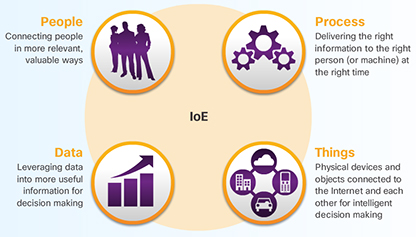2.1 The four pillars
The idea of connecting things is not a new one. In fact, the internet of things (IoT) is a term that has been broadly accepted since the late 1990s. The IoT refers to the network of physical objects accessible through the internet.
Not all of the objects that connect to the IoT will be computing devices, but many will be. So, what is a computing device? While it may be easy to identify a desktop or a laptop computer, the line between what is and is not a computer can become blurred. Is a car a computing device? What about a watch or a television?
The first computing devices (computers) were huge, room-sized machines that took teams of people to build, manage and maintain. Today, they are exponentially faster and only a fraction of the size of their predecessors. For the purposes of this course, a computing device is an electronic machine that performs calculations based on a set of instructions and comprises three main components: a central processing unit (CPU), memory, and an input/output unit.
Based on the definition above, a digital watch is a computing device, but an analogue watch is not. The digital watch has a CPU to run its program, it has memory to store the program and other information, and it has an I/O device to allow user interaction (screen, display, buttons, sound alerts, etc.). Although the analogue watch has the I/O component, it lacks CPU and memory.

